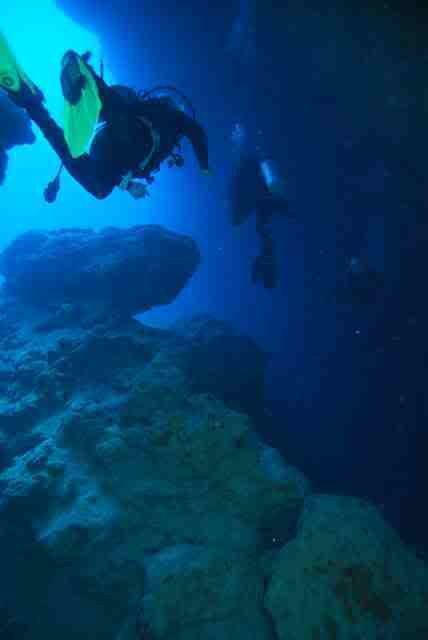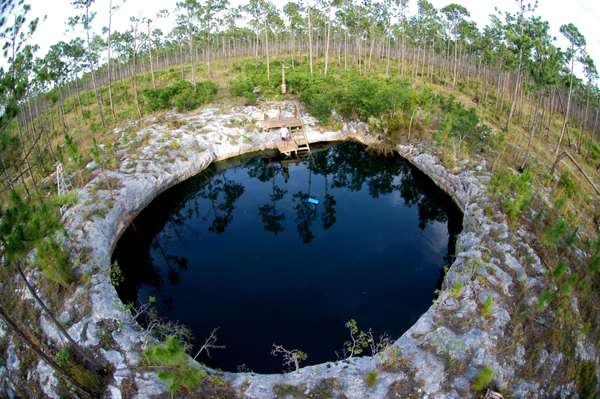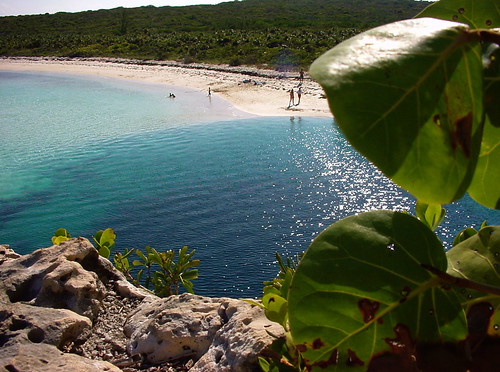The Great Blue Hole is located in the Light House Reef and lies 60 miles from the Island of Belize. In 1997 it was designated as a World Heritage site.
Found on both land and in the ocean throughout the Bahamas are deep circular cavities known as Blue Holes which are often the entrances to cave networks, some of them up to 14 kilometres in length. Divers have reported a vast number of aquatic creatures some of which are still new to science. In addition, they’ve recorded chambers filled with stalactites and stalagmites which only form in dry caves. For the explorers this was proof that at one time, nearly 65,000 years ago, when the world was in the grip of the last major ice age, the sea level of the Bahamas was up to 150 metres lower than it is today. Over time the limestone of the islands was eroded by water and vast cave networks created. When sea levels rose again about 10,000 years ago some of these collapsed inwards land the Blue Holes were formed...
Walls and blue holes are simultaneously special, and widespread, dive experiences in The Bahamas. Walls, the most generally dramatic expression of the coral reef, will at times plummet directly into the great trenches, thousands of feet deep, that line the archipelago. Blue holes, while not exclusively a phenomenon of The Bahamas, are found here in a greater number than anywhere on earth. And, The Bahamas has the only known tidal blue holes in the world. Together, the walls and blue holes turn The Bahamas dive experience on its side. Blue holes are a phenomenon created during several ice ages, when sea levels were 400 feet lower and The Bahamas was a great exposed limestone platform. Centuries of acidic rain water etched into the vast bank, creating circular depressions and other magnificent formations. Today, most blue holes are located in shallow water on the Great and Little Bahama Banks, while others are inland pools.


















Found on both land and in the ocean throughout the Bahamas are deep circular cavities known as Blue Holes which are often the entrances to cave networks, some of them up to 14 kilometres in length. Divers have reported a vast number of aquatic creatures some of which are still new to science. In addition, they’ve recorded chambers filled with stalactites and stalagmites which only form in dry caves. For the explorers this was proof that at one time, nearly 65,000 years ago, when the world was in the grip of the last major ice age, the sea level of the Bahamas was up to 150 metres lower than it is today. Over time the limestone of the islands was eroded by water and vast cave networks created. When sea levels rose again about 10,000 years ago some of these collapsed inwards land the Blue Holes were formed...
Walls and blue holes are simultaneously special, and widespread, dive experiences in The Bahamas. Walls, the most generally dramatic expression of the coral reef, will at times plummet directly into the great trenches, thousands of feet deep, that line the archipelago. Blue holes, while not exclusively a phenomenon of The Bahamas, are found here in a greater number than anywhere on earth. And, The Bahamas has the only known tidal blue holes in the world. Together, the walls and blue holes turn The Bahamas dive experience on its side. Blue holes are a phenomenon created during several ice ages, when sea levels were 400 feet lower and The Bahamas was a great exposed limestone platform. Centuries of acidic rain water etched into the vast bank, creating circular depressions and other magnificent formations. Today, most blue holes are located in shallow water on the Great and Little Bahama Banks, while others are inland pools.
Wall Diving in The Bahamas
Walls are found throughout The Bahamas and their profiles range from those that end at sand bottoms 60 to 100 feet deep, to seemingly infinite vertical descents. It is along these escarpments of the deep reef that the majesty of coral spires and the magnificence of sponges is fully realized. Seafans, bryozoans, seawhips and Black Coral mix and mingle with the sponges, creating a garden carpet of life. More color and the addition of motion is provided from solitary and schooling reef fish. Every wall is similar, yet different: Profile, shape, size and predominant colors vary from site to site. The following walls are among the most stunning, popular and accessible in The Bahamas:- The Great Lucaya or Grand Bahama Wall
- Lyford Cay Wall
- Southwest Wall
- The Andros Wall
- The Bimini Wall
- The Exuma Wall
- Chub Cay Wall
- Riding Rock Wall
- Conception Island Wall
- Diving the Blue Holes





















 10:34 AM
10:34 AM
 crkota
crkota








 Posted in:
Posted in: 



1 comments:
Great Article, thanks..
There are myriad reasons why you might choose to visit Bahamas America in Holidays.
http://www.holidayinfoguide.com
Post a Comment